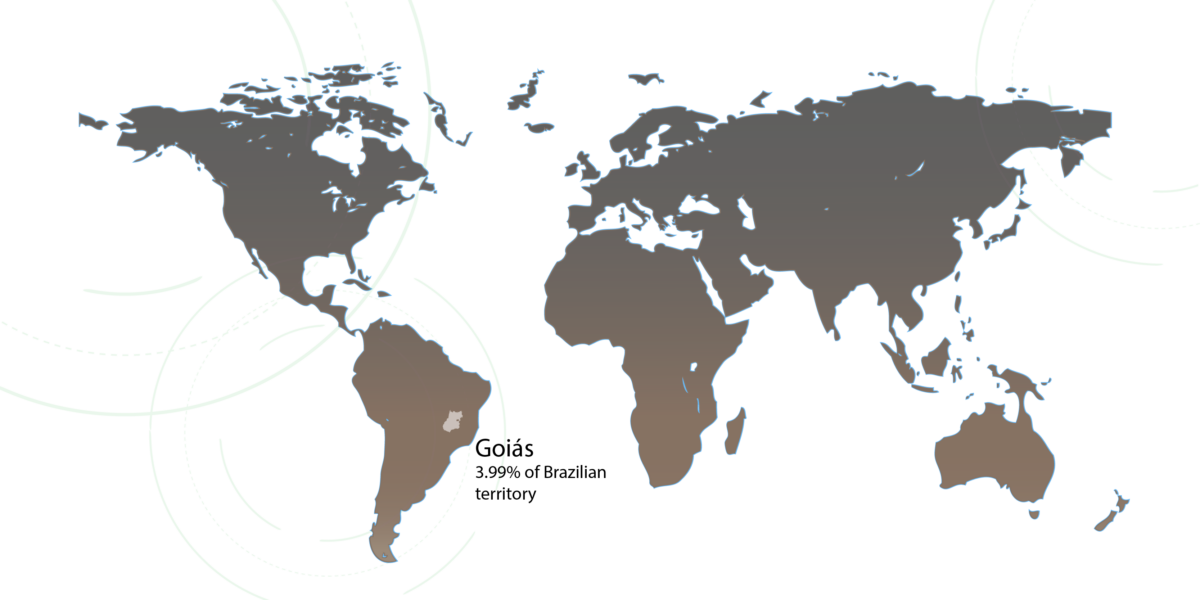Goiás – Overview
Click here to download the bilingual file format for graphical printing.
See also our periodical with Statistics for the State of Goias.
Summary
Goiás, one of the 26 Brazilian states, is located in the country’smid west region occupying an area of 340,106 km². As the seventh state in territorial area, Goiás has a privileged geographic position. Goiás is boundedon the north with the State of Tocantins, on the south with Minas Gerais and Mato Grosso do Sul, on the east with Bahia and Minas Gerais and finally on the west with Mato Grosso. Goiás has 246 municipalities and a population of 6,921 millions in habitants.
Goiânia, its capital, is the polarizing nucleus of the Metropolitan Region, agglomerated of 20 municipalities that shelters 2,494 million inhabitants and 40% of the Gross Domestic Product of Goiás. Economic growth with great opportunities is the attraction of many migrants. Despite hosting large industries, the Services sector is the mainstay of its economy. The capital is a center of excellence in medicine and has been consolidating its vocation for business tourism and events. Besides presenting good indexes of quality of life, above the national average, Goiânia is one of the cities with the greenest urban area of the country.
Tropical climate predominates in Goiás, with twowell defined seasons: a moist summer and a dry winter; the average temperature varies between 18°C and 26°C. The rainfall index from September to April fluctuates between 1,200 to 2,500 mm, being more concentrated rains during the summer.
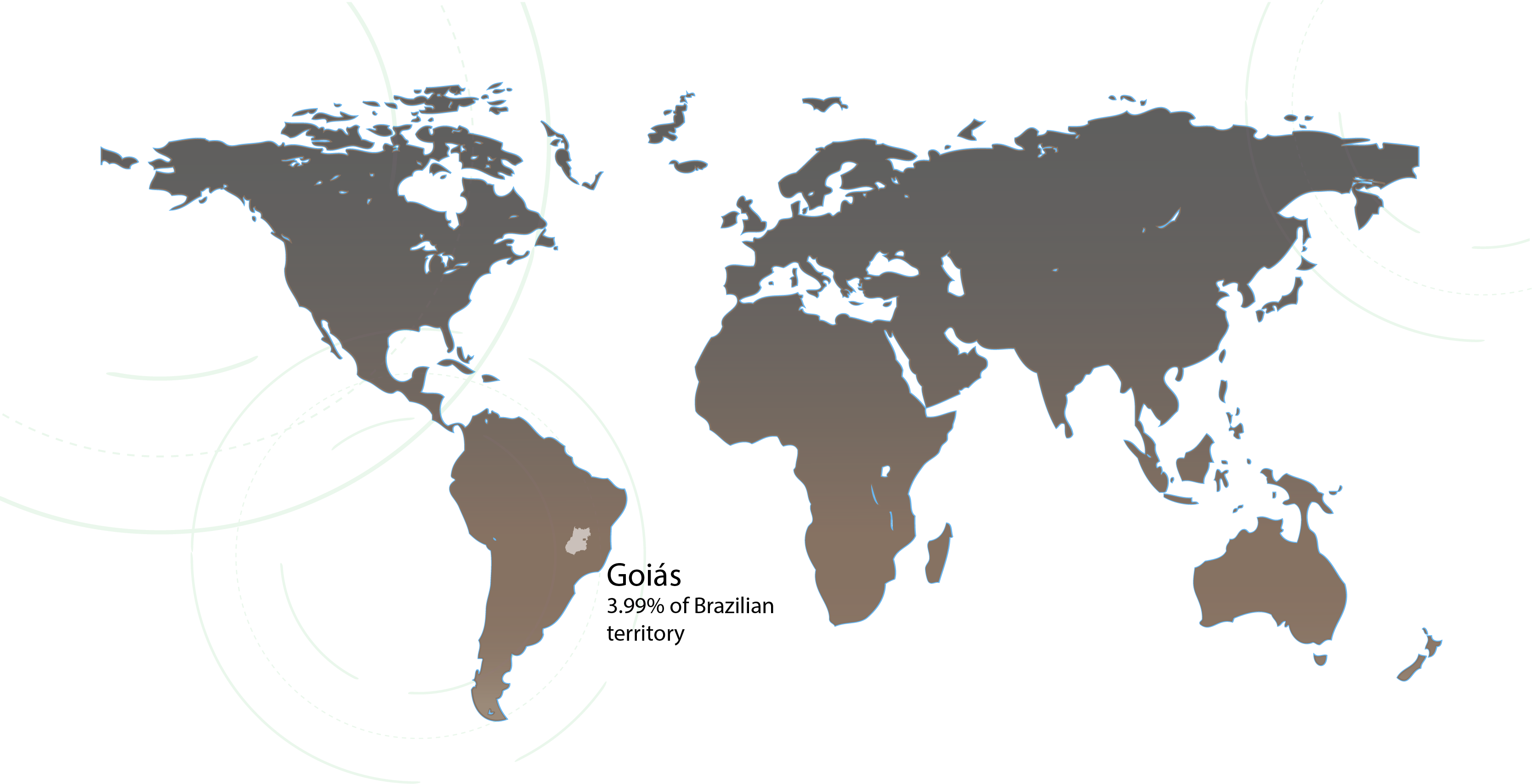
|
Distance from Goiânia to the Main Brazilian State Capitals |
|
|
Capital |
Distance in km |
|
Belém |
2,046 |
|
Belo Horizonte |
874 |
|
Brasília |
210 |
|
Campo Grande |
877 |
|
Cuiabá |
934 |
|
Curitiba |
1,226 |
|
Florianópolis |
1,536 |
|
Fortaleza |
2,609 |
|
Manaus |
3,291 |
|
Porto Alegre |
1,847 |
|
Recife |
2,434 |
|
Rio de Janeiro |
1,338 |
|
São Paulo |
936 |
|
Vitória |
1,386 |
|
Settled by: Mauro Borges Institute/ Segplan-GO – 2018. |
|
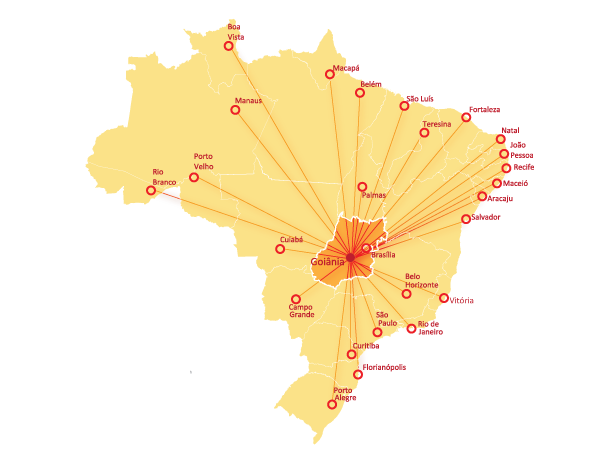
|
Goiás State General Data |
|
|
Quantity of Counties |
246 |
|
Population of Goiás (2018) (hab) |
6,921,161 |
|
Demographic density (2017) (hab/km2) |
340,106.492 |
|
Demographic density (2018) (hab/km2) |
20.85 |
|
Population of the State/Brazil (%) |
3.3 |
|
IDHM – Human Dev (2015) |
0.756 |
|
Rate of urbanization (%) (2015) |
91.63 |
|
Unemployment Rate (%) (jul/set – 2017) |
9.2 |
|
Rate of infant mortality (per 100 mil hab) (2017) |
14.52 |
|
Life expectancy at birth (in years) (2017) |
74.3 |
|
Source: IBGE, PNUD. Settled by: Mauro Borges Institute/ Segplan-GO – 2018. |
|
|
Distance from the Capital to the Selected Cities in the State |
|
|
City |
Distance in Km |
|
Anápolis |
53 |
|
Rio Verde |
216 |
|
Aparecida de Goiânia |
18 |
|
Catalão |
258 |
|
Senador Canedo |
16 |
|
Itumbiara |
203 |
|
Luziânia |
186 |
|
Jataí |
305 |
|
São Simão |
351 |
|
Trindade |
18 |
|
Pirenópolis |
118 |
|
Caldas Novas |
165 |
|
Goianésia |
168 |
|
Rio Quente |
176 |
|
Cristalina |
275 |
|
Niquelândia |
347 |
|
Alto Paraíso de Goiás |
425 |
|
Source: AGETOP. Settled by: Mauro Borges Institute/ Segplan-GO – 2018. |
|
|
Most Populated Municipalities in Goiás – 2018 |
|
|
City |
Population (hab) |
|
Goiânia |
1,466,105 |
|
Aparecida de Goiânia |
542,090 |
|
Anápolis |
375,142 |
|
Rio Verde |
217,048 |
|
Luziânia |
199,615 |
|
Águas Lindas de Goiás |
195,810 |
|
Valparaíso de Goiás |
159,500 |
|
Trindade |
121,266 |
|
Formosa |
115,789 |
|
Novo Gama |
110,096 |
|
Senador Canedo |
105,459 |
|
Itumbiara |
102,513 |
|
Catalão |
102,393 |
|
Jataí |
98,128 |
|
Planaltina |
88,863 |
|
Source: IBGE. Settled by: Mauro Borges Institute/ Segplan-GO – 2018. |
|
Gross Domestic Product(GDP)
Goiás is the ninth Brazilian economy with a GDP of R$ 189 billion (estimated for 2017), which represents 2.8% of the national GDP. Its per capita income is R$ 27,457.63. Between 2010 and 2017, Goiás GDP grew at an average rate of 1.4% per year, above the national performance, which stood at 0.48%. This good performance maintained Goiás in the select group of the 10 largest economies among the states of the Federation.
The expressive result is due to the evolution of the agribusiness of Goiás, of commerce and also to the growth and diversification of the industrial sector. This sector had its major highlights in the food and beverage, automobile, drug manufacturing, mineral processing and, more recently, in the sugarcane production chain.
|
Produto Interno Bruto – Vários Anos |
||||
|
Year |
Current Values (R$ Million) |
Growth Rate (%) |
||
|
Goiás |
Brasil |
Goiás |
Brasil |
|
|
2010 |
106,770 |
3,885,847 |
– |
– |
|
2011 |
121,297 |
4,376,382 |
5.8 |
4.0 |
|
2012 |
138,758 |
4,814,760 |
4.5 |
1.9 |
|
2013 |
151,300 |
5,331,619 |
3.1 |
3.0 |
|
2014 |
165,015 |
5,778,953 |
1.9 |
0.5 |
|
2015 |
173,632 |
5,995,787 |
-4.3 |
-3.5 |
|
2016* |
178,948 |
6,266,895 |
-2.8 |
-3.5 |
|
2017* |
189,129 |
6,593,000 |
1.9 |
1.0 |
|
Source: IBGE, IMB. Settled by: Mauro Borges Institute/ Segplan-GO – 2018. |
||||
|
Gross Domestic Product per capita Per Capita – 2010-17 |
||
|
Year |
Current Values (R$) |
|
|
Goiás |
Brasil |
|
|
2010 |
17,783.32 |
20,371.64 |
|
2013 |
23,470.48 |
26,445.72 |
|
2014 |
25,296.60 |
28,500.24 |
|
2015 |
26,265.32 |
29,326.33 |
|
2016* |
26,725.23 |
30,410.31 |
|
2017* |
27,457.63 |
31,748.87 |
|
Souce: IBGE, IMB. Settled by: Mauro Borges Institute/ Segplan-GO – 2018. |
||
Composition of the GDP
Among the large sectors of economic activities, Services is the main one at Goiás, with 65.6% of the wealth production. In this sector can be highlighted the trade, the retailer and the wholesaler, that are dynamic, mainly in the capital. The industrial sector participates in the GDP of Goiás in 24.5% and the farming with 10.4% (2015 data). Although it’s inferior share, the farming sector has great importance for Goiás economy, to the agricultural industry, one of the activities more powerful of the state, as well as in the production of meats, milk derivatives and soya, tomato sauces and seasoning and other items of the food industry, and also the ethanol production.
|
Composition of Gross Domestic Productin Goiás – 2015 |
|||
|
Activity |
Added Value |
||
|
Current Prices (R$ Million) |
Participation (%) |
||
|
Farming |
16,107 |
10.4 |
|
|
Industry |
37,806 |
24.5 |
|
|
Services |
100,660 |
65.1 |
|
|
Source: IBGE, IMB. Settled by: Mauro Borges Institute/ Segplan-GO – 2018 |
|||
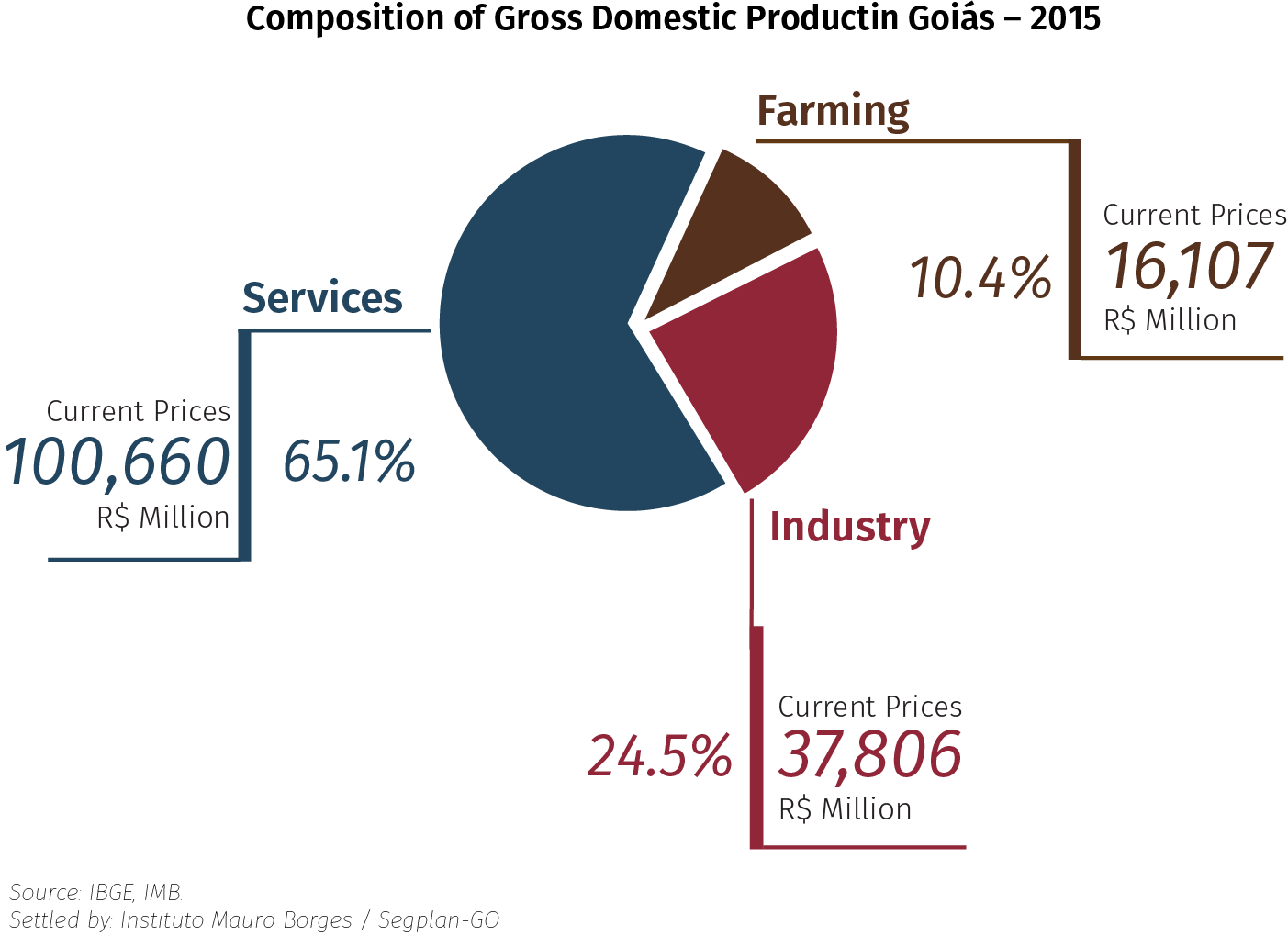
|
Municipal Largest Economies of Goiás – 2015 |
|
|
Municipalities |
GDP (R$ thousand) |
|
Goiânia |
46,632,596 |
|
Anápolis |
13,301,497 |
|
Aparecida de Goiânia |
11,518,675 |
|
Rio Verde |
8,078,600 |
|
Catalão |
5,679,221 |
|
Itumbiara |
3,971,950 |
|
Jataí |
3,842,145 |
|
Luziânia |
3,353,547 |
|
São Simão |
3,106,227 |
|
Senador Canedo |
2,685,910 |
|
Total dos Municípios |
102,172,383 |
|
Participação no estado (%) |
58.84 |
|
Estado de Goiás |
173,631,663 |
|
Settled by: Mauro Borges Institute/ Segplan-GO – 2018. |
|
Economic Sectors
Farming
In spite of the increasing industrialization, farming remains the developmental key of Goiás. The state is the fourth national grain producer. Its production is around 16.98 million tons. It represents 9% of the domestic production. The agricultural activity, comes from soya, sorghum, corn, sugar cane, beans, tomato, among other products.
The livestock of Goiás, highly expressive, puts the state among the great producers of the country. The bovine herd is the 2th in the Brazilian ranking, formed by 22.8 million heads, with share of 10.6% in the national effective. Swine breeding and poultry farming are also consolidated, mainly in the Sudoeste Goiano region. The state is positioned in 6th place in the national ranking, with 5.0% and 5.3% of Brazilian production, respectively. The stock of these herds has grown much since the 2000s with the coming of large companies that operate in the meat sector.
|
State of Goiás: Main Agricultural Products – 2018* |
||
|
Product |
Quantity (Tonnes) |
Participation Goiás/Brazil (%) |
|
Sugar Cane |
76,082,607 |
11.08 |
|
Soya |
11,369,134 |
9.74 |
|
Corn |
8,691,532 |
10.73 |
|
Tomato |
1,368,567 |
31.37 |
|
Sorghum |
978,870 |
46.50 |
|
Beans |
325,100 |
10.00 |
|
Cotton |
100,802 |
2.11 |
|
Source: IBGE. Settled by: Mauro Borges Institute/ Segplan-GO – 2018. |
||
|
State of Goiás: Slaughter of Animals– 2017 |
||
|
Type of Animal |
Nº of Heads |
Participation Goiás/Brazil (%) |
|
Poultry |
378,602,112 |
6.5 |
|
Cattle |
3,179,805 |
10.3 |
|
Swine |
1,760,903 |
4.1 |
|
Source: IBGE. Settled by: Mauro Borges Institute/ Segplan-GO – 2018. |
||
Industry
Goiás is highlighted of the food national industry, mining, medicines, car and ethanol. It is one of the leaders in the national ranking of agricultural and mineral commodities and generic medicines production. It is also inserted in the geography of the world car industry, with two car manufacture plants and one of agricultural machines – the car industry of Goiás already participates in 1.8% of the Brazilian vehicle production. With the arrival of the third automaker, Goiás will become the third in the automotive ranking of the country.
The state is the second largest domestic producer of sugarcane with 76 million tons. As a result, Goiás is the second largest national ethanol producer whose production in the 2017/2018 harvest reached 4.6 billion liters. Still, in sugar production the state is the 2th largest with 2.3 million tons. In order to do so, the number of plants installed in Goiás increased considerably. There are currently 36 active plants, one in implantation and two suspended ones.
The mining industry of Goiás is diversified, presenting modern segments and similar management to those big international corporations, adjusting to the scenario of the global economy. There are seven poles distributed along the state, with production of copper, gold, cobalt, nickel, niobium, phosphate and vermiculite that occupy important positions in the national productive chain.
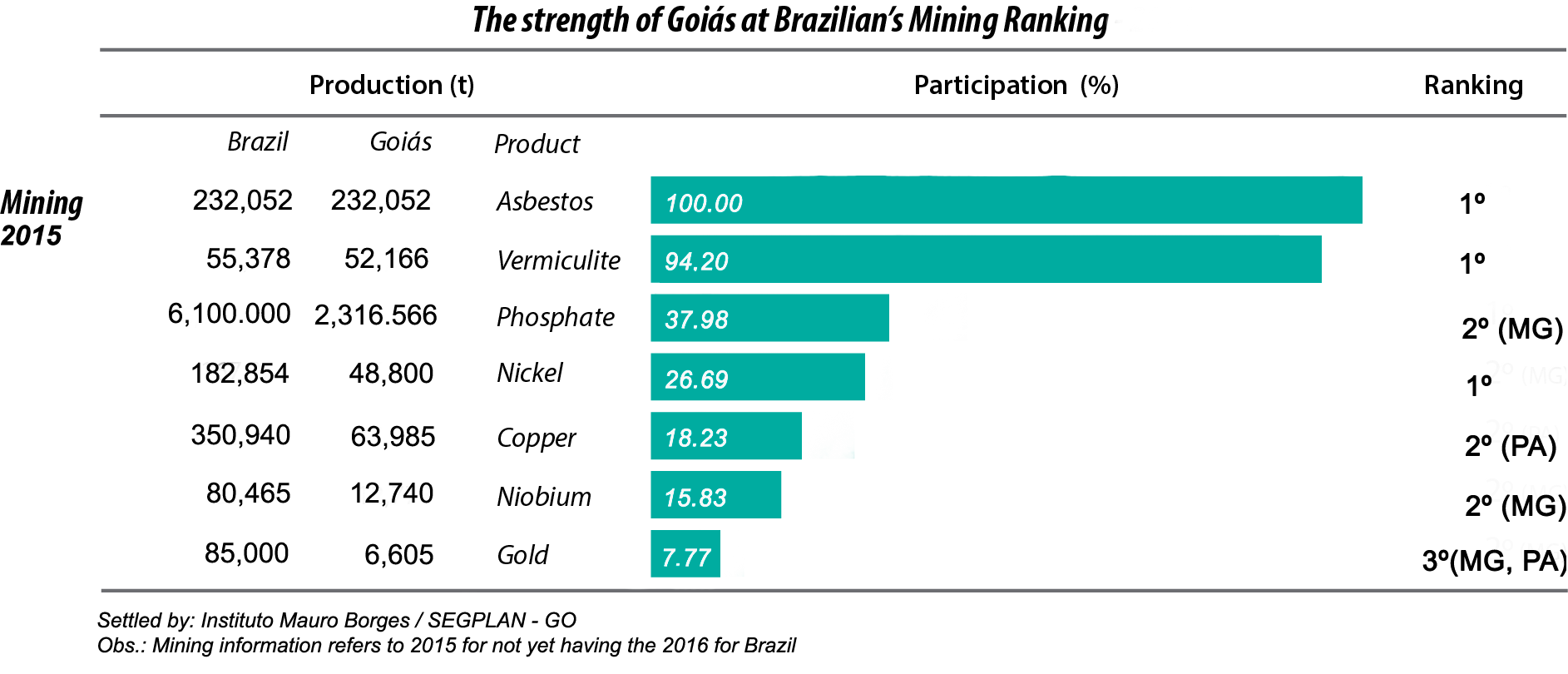
The productive diversification of the industry of Goiás has occurred due to investments of large private companies installed or being installed. The main industrial activities of Goiás are the food and beverage, mining and automotive and agricultural machinery.
|
Structure of the Industry in Goiás Participation of the main industrial activities – 2015 (%) |
|
|
Activities |
Participation (%) |
|
Transformation industry |
100.0 |
|
Food and drinks |
37.3 |
|
Manufacture of alcohol |
8.5 |
|
Automobiles, trucks and commercial vehicles |
7.0 |
|
Medicines |
6.9 |
|
Non-Metallic Minerals |
4.7 |
|
Chemicals (fertilizers, fertilizers, pesticides) |
3.4 |
|
Metallurgy |
2.7 |
|
Other segments |
28.5 |
|
Source: IBGE-PIA Empresa. |
|
Foreign Trade
Goiás is presenting in recent years a good performance as an exporter. In 2017, exports totaled US$ 6.9 billion and imports US$ 3.2 billion. The export reflects the competitive advantages of Goiás in natural resources, being concentrated in basic products, mainly agricultural commodities and minerals, such as: soybean and meat complexes, corn, copper and ferroalloys, mainly. Total external trade reached US$ 10.1 billion in 2017. In 2005 was $2.5 billion.
China, Netherlands, India, Russia and Iran were the main destinations of Goiás products in 2017. The imported goods come mainly from the United States, Germany, South Korea, Japan and China, with the bulk of the purchases made items for vehicle manufacturers and the agricultural inputs and machinery for the pharmaceutical and fertilizer industries installed in the state. In 2017, Goiás traded with 154 countries.
|
Main Exportation Products – Goiás – 2017 |
||
|
Products |
US$ FOB (In Million) |
Participation (%) |
|
Export |
6,905.34 |
100.00 |
|
Soy complex |
2,680.87 |
38.82 |
|
Ore complex |
1,424.04 |
20.62 |
|
Iron garters |
562.05 |
8.14 |
|
Copper ore sulphide |
429.23 |
6.22 |
|
Gold |
369.98 |
5.36 |
|
Asbestos |
53.82 |
0.78 |
|
Meat complex |
1,245.40 |
18.04 |
|
Beef |
803.57 |
11.64 |
|
Poultry meat |
346.50 |
5.02 |
|
Pig meat |
80.29 |
1.16 |
|
Corn and Byproducts |
538.20 |
7.79 |
|
Sugars |
364.42 |
5.28 |
|
Leather |
290.69 |
4.21 |
|
Other products |
361.73 |
5.24 |
|
Source: MDIC. Settled by: Mauro Borges Institute/ Segplan-GO – 2018. |
||
|
Main Imported Products – Goiás – 2017 |
||
|
Products |
US$ FOB (In Million) |
Participation (%) |
|
Import |
3,237.28 |
100.00 |
|
Pharmaceutical products |
1,106.20 |
34.17 |
|
Motor vehicles, tractors and accessories |
467.74 |
14.45 |
|
Fertilizers |
463.97 |
14.33 |
|
Nuclear reactors, boilers, machinery etc. |
294.07 |
9.08 |
|
Organic chemicals |
271.57 |
8.39 |
|
Other Products |
633.73 |
19.58 |
|
Source: MDIC. Settled by: Mauro Borges Institute/ Segplan-GO – 2018. |
||
|
State of Goias – Export and Import, Main countries of destination and origin of foreign trade |
|||||
|
Countries of Destiny |
Exportation |
Countries of Origin |
Importation |
||
|
US$ FOB (In Million) |
Participation (%) |
US$ FOB (In Million) |
Participation (%) |
||
|
China |
2,124.37 |
30.8 |
United States |
560.83 |
17.3 |
|
The Netherlands |
536.66 |
7.8 |
Germany |
463.32 |
14.3 |
|
India |
390.59 |
5.7 |
South Korea |
346.26 |
10.7 |
|
Russia |
274.85 |
4.0 |
Japan |
239.71 |
7.4 |
|
Iran |
248.90 |
3.6 |
China |
223.28 |
6.9 |
|
TOTAL |
6,905.34 |
|
TOTAL |
3,237.28 |
|
|
Source: IBGE. Settled by: Mauro Borges Institute/ Segplan-GO – 2018 |
|||||
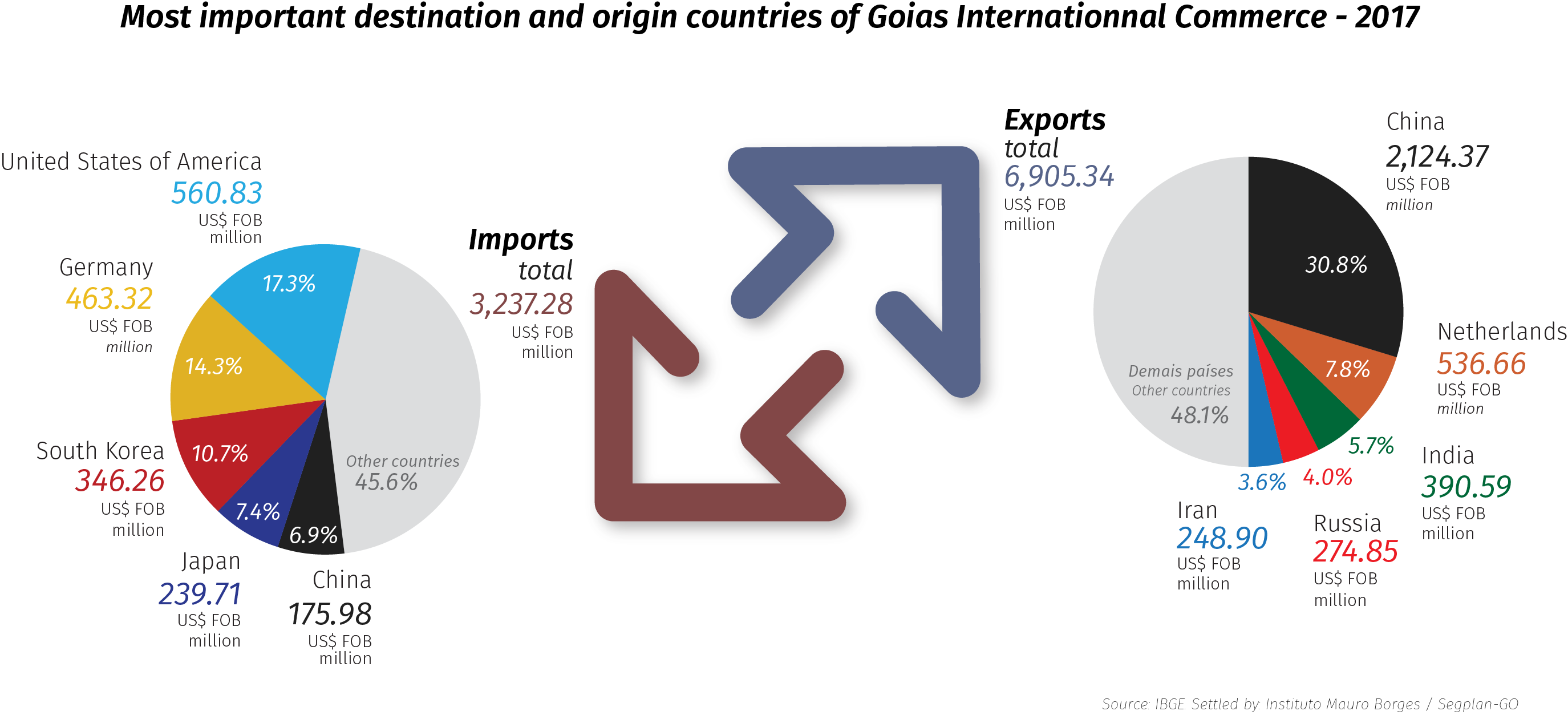
Infraestructure
Highways
The road network in Goiás consists of 28.0 thousand km of highways, of which 53% are paved. There are 1,278.7 km of duplicated highways being 60% of them federal and the remaining state. The main federal highways of the state are the BR-153 that crosses all its extension connecting the north to the south of the country, the BR-060, that connects Goiânia to Brasília as well as the Southwestern Goiano and BR-050, that connects the Federal District to the south of Brazil.
Railways
Goiás has 685 km of the Ferrocarril Centro-Atlântica (FCA) that serves the southeast of the state and the Federal District. The FCA is 7,080 km long and is considered the main and most efficient link between the Northeast, Southeast and Midwest regions of Brazil. It integrates large ports such as Vitória-ES, Santos-SP, Angra dos Reis-RJ, from Salvador (BA) and Porto Seco de Anápolis-GO. It is a great corridor of import and export of products to Goiás as: sugar, fertilizers, petroleum and alcohol derivatives, steel products, soy and soybean meal, phosphate, pig iron, ores, general cargo containers.
The North-South Railroad between Anápolis-GO and Açailândia-MA is ready for operation and will be integrated to the section of the Carajás Railroad that leads to the port of Itaqui in Maranhão. Another section of the North-South railroad, 1,537 kilometers between Porto Nacional (TO) and Estrela d’Oeste (SP), which passes through Goiás, that there is still a concession for operation. This railroad has, in Goiás territory, 991 km of rails, which will cross the north, central and southwest of the state. The expectation is that it will change the economic profile of Central Brazil. When in operation, this modal will allow reaching the ports of the north of the country and consolidate the city of Anápolis as an unprecedented logistic reference in the center of Brazil.
Goiás will also be contemplated with an excerpt from the West-East Integration Railway (Fiol). This railroad is the first part of a major project, the 4,400-kilometer Transcontinental Railroad, which will link the Brazilian coast to the Brazil-Peru border. There are stretches between Ilhéus-BA and Figueirópolis-TO under construction, since the stretch from the state of Tocantins is not predicted to start. The Goian section of this railway will be 210 km, leaving Campinorte and passing through the municipalities of Nova Iguaçu de Goiás, Pilar de Goiás, Santa Terezinha de Goiás, Crixás and Nova Crixás until reaching the border with Mato Grosso.
Port of São Simão
With 2,400 km of extension, the Tietê-Paraná Waterway has the most important route between São Simão-GO and Pederneiras (SP), being responsible for the transportation of a large part of grains and farms of the Midwest, which favors economically and safeguards the flow of part of the Goiás production of grains. The São Simão Port Complex, located on the right bank of the Paranaíba River in the south of Goiás, transports wood, coal, fertilizer and sand, but also large companies transport soy, soybean meal and corn. Therefore, through this port passes a good part of the products that predominate in the export tariff. The goods go from São Simão to Pederneiras or Anhembi-SP in barges and then they follow by rail modal or road until the port of Santos-SP. The São Simão complex has total storage capacity, totaling 2.506 million tons per year.
Internal Custom Station – Porto Seco of Anápolis
The Porto Seco Centro Oeste S/A is a customs terminal for public use for the storage and movement of domestic goods, imported or destined for export, and is used as a facilitator of foreign trade operations. Serves the agriculture, steel, construction and pharmochemical sectors; forest products and minerals; consumer goods (food, beverages and textiles) and durable goods (automobile and consumer electronics), among others. There is an area of approximately 400 thousand m² with structure and capacity to meet the flow of goods from the domestic and foreign markets. It offers competitive advantages for companies that seek to enable the storage and handling of their cargo with total safety and reliability.
In terms of logistics, the location of Porto Seco Goiano is the best in the entire Brazilian interior. It is located in the city of Anápolis, 53 km away from the state capital, Goiânia, and 159 km from Brasília, where important highways intersect. When in operation, the North-South Railroad will be connected to the railway branch of the FCA – Ferrovia Centro-Atlântica. By joining the road and rail ways, through the Dry Port of Anápolis can be transported the most diverse types of cargo, interconnecting the entire market of the Center-West to other parts of the country.
Thus, the municipality of Anápolis is about to represent the zero mark of the interconnection between the North-South and Central-Atlantic railroads. The handling and distribution operations of the Porto Seco Centro Oeste S/A will put the municipality in the route of the great logistic projects of Brazil, increasing its operational capacity and of connection with the North, Northeast, South and Southeast regions.
Multimodal Logistical Platform of Goiás
The Multimodal Logistics Platform of Goiás, in the phase of implementation in Anápolis, will consolidate the city as one of the main distribution centers of the country. Anápolis, due to its strategic location, is considered the “Trevo do Brasil”, due to the natural ease of integration with other consumer centers in the country. In a radius of 1,000 kilometers, it is around 75% of the Brazilian consumer market. It is approximately two hours flight to most of the capitals of the country. This condition will be strengthened by the intelligent integration of various modes (terminals, warehouses, highway and rail).
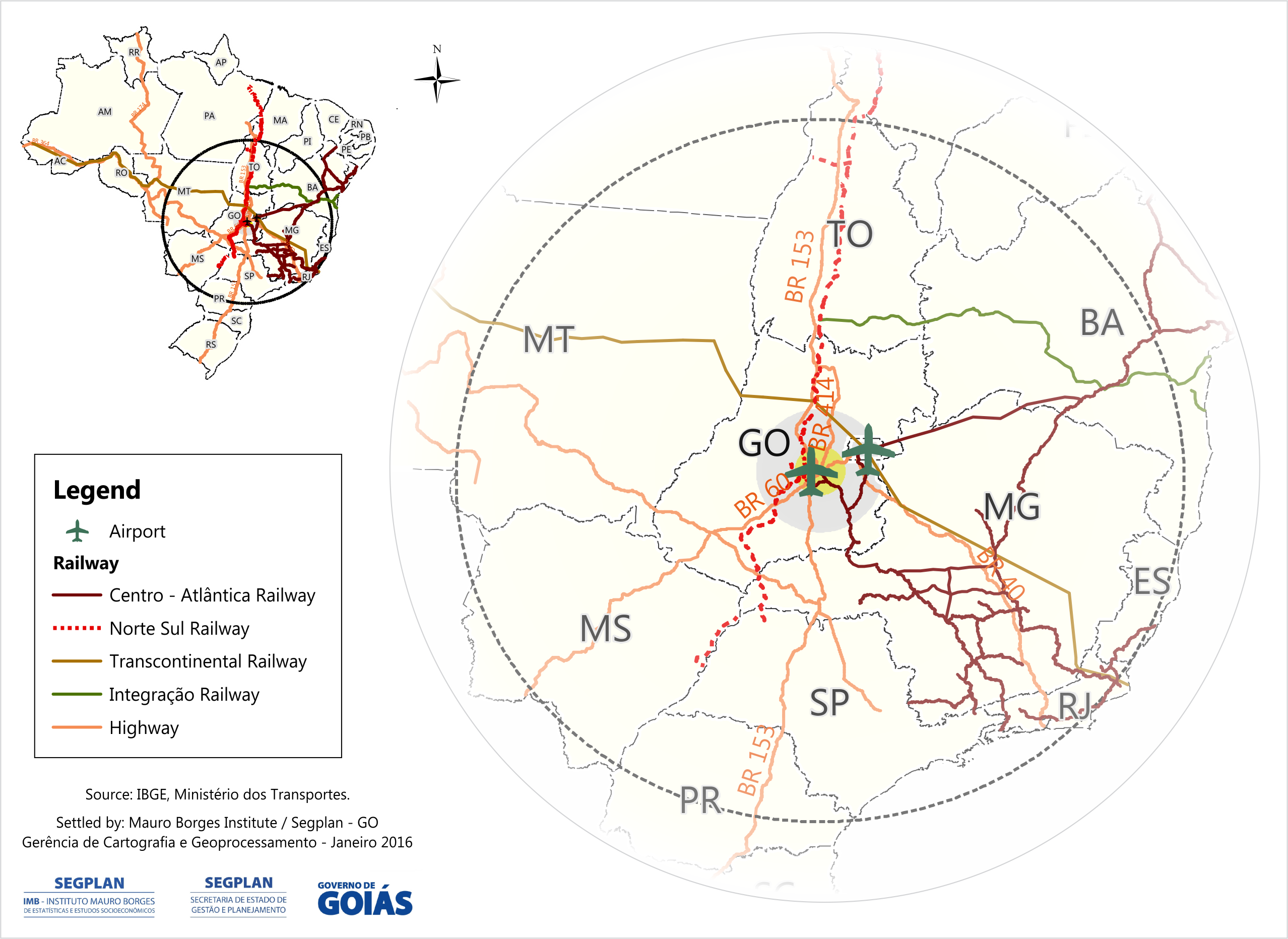
Anápolis also has the largest industrial district in the state, the DAIA-Agribusiness District of Anápolis with about 154 companies installed. The Industrial District houses the 2nd pharmaceutical center in Brazil with about 20 companies, as well as other industries. As for the air modal, the Airport of Cargas de Anápolis that is in final phase of completion of its works, lacking only the works of the maneuvering yard and the hangars, will allow the movement of aircraft with 400 tons of cargo.
The overall design of this platform provides air freight terminals, international cargo airport hub services and administration, road freight center and rail freight terminal. When operating, the Logistics Platform will combine multimodality, telematic and optimization of freight, thus promoting the concept of central logistics intelligence.

Energy
The Goian electric generator park stands out for the generation of electricity through renewable energy, mainly the hydraulics, due to the availability of sources and its generation costs that are technically and economically viable and very important for the sustainability of its energy matrix.
The electric generator park is composed of 147 plants in operation with installed capacity of 7,574,929 KW of power. Of this total, 71.1% is generated by hydroelectric plants and 23.3% by thermoelectric plants. In addition to the plants in operation, there are 18 others under construction or concession concession, whose potential sum 369,088 kW. The accelerated expansion of the sugarcane industry allows, in addition to the production of sugar and ethanol, also the implementation of cogeneration projects, which contribute to the electric generator generation in Goiás.
There are 96 thermoelectric power plants in operation in Goiás, whose generation potential amounts to 1,761,976kW, the main fuels being sugarcane bagasse and diesel oil. Still, there are 5 thermoelectric plants under construction and in grant that will contribute with an additional 118,780 kW for the state generation system.
Lines of Development
The Industrial Development Program of the State of Goiás “Produzir” (to produce) was created to contribute with the expansion, modernization and diversification of the industrial economy of Goiás, stimulating the investments of production, the technological renewal and the increase of the State competitiveness. It favors the reduction of production cost of companies, through the financing of up to 73% of the ICMS (tax for products) due by the period of 15 years.
The “Produzir” has the following releases:
- “Microproduzir” (incentive to the micro companies);
- “Teleproduzir” (incentive to the implementation of call centers);
- “Centroproduzir” (incentive to erect distribution centers);
- “Logproduzir” (incentive to companies acting in logistics) and
- “Comexproduzir” (Incentive to foreign trade operations);
Besides those incentive programs, Goiás still has resources from the Constitutional Fund of the Midwest (FCO). The FCO was created in 1988 with the objective of contributing to the economic and social development of the Brazilian Midwest. The permanent contribution of the resources of the Fund by the Union (29% for Goiás, 29% for Mato Grosso, 23% for Mato Grosso do Sul and 19% for the Federal District) provides long-term financing for the economic sectors, generating new investment prospects for the business community.
Goiás captures on average 27% of the FCO or R$ 4 billion annually in investments. Of this contribution, about 50% were directed to the business modality and 50% to finance rural activities.
Environment
The territory of Goiás is predominantly covered by the Cerrado vegetation, with trees and bushes of tortuous branches, thick shells, and leaves covered with fur and deeper roots. Goiás is the state with major presence of Cerrado in the country, having more than 90% of the territory covered by this biome.The Cerrado is the second largest Brazilian and South American biome, after Amazonia. The Cerrado concentrates 1/3 of the national biodiversity and 5% of flora and fauna of the world. The Flora is considered the richest of the world and it is estimated that between 4,000 to 7,000 species dwell this region. The biome was classified as one of the 34 priorities areas of the world for conservation of the biodiversity.
The territory of Goiás has two national parks (das Emas e Chapada dos Veadeiros) and also eleven state parks, among them Park of Serra de Caldas Novas and Park of Terra Ronca, in addition to many other environmental protection unities.
The territory of Goiás has two national parks: das Emas and Chapada dos Veadeiros; 12 (twelve) areas defined as state parks, where the Serra de Caldas Novas Park and the Terra Ronca Park stand out, as well as innumerable other environmental protection units.
Higher Education
The current network of governmental and private institutions of education in the State of Goiás offers suitable conditions for qualification of technical labor professional course and college level, emphasizing the Federal University of Goiás (UFG), State University of Goiás (UEG), Federal Institute of Education, Science and Technology of Goiás (IFG) with 27 campi, 4 municipal institutions, distributed in several regions of the state, in addition to private college education institutions with 85 establishments.The network of higher education in Goias held 209,158 registrations and the number of graduates was 31,111.
Tourism
The tourism in Goiás is anchored by its natural beauties given by the luxuriant fauna and flora of the Cerrado, beautiful cascades, mountains, rivers and plateaus, as also in the recognized historical heritage, with highly representative cultural traditions and culinary rich and tasty. There are nine regions that divide Goiás in a real discover route, adventures, rest and a lot of fun, among which are emphasized:
- Agricultural-ecological region – includes the Parque Nacional das Emas – Natural Site of the World Heritage and Reserve of the Biosphere of Pantanal, recognized by the UNESCO.
- Vale do Araguaia region – this river became one of the better poles of ecotourism, leisure, camping and sport fishing of the country. The entrance gates for the river are the cities of Aragarças, Aruanã and the towns of Bandeirantes and Luís Alves.
- Do Ouro region – includes cities of Pirenópolis (Historical National Heritage), Corumbá de Goiás (State Historical Site), City of Goiás (Historical Site of the World Heritage) and the State Park of Serra dos Pirineus.
- Das Aguas region – “the largest hydrothermal source of the world”, with temperatures that vary from 30° to 57ºC and proven therapeutic capacity, is located in Caldas Novas and Rio Quente, municipalities where is found the largest hotel complex of Goiás.
Ecotourism is practiced in the state because of the two major national parks of Brazil, the Chapada dosVeadeiros and Nacional Park of Emas. Goiás has the second most important archeological site in Brazil, in Serranópolis, one of the greatest rock fields with diversity of flora of Brazil, located in the state Park of the Pyrenees in Pirenópolis, and the beautiful rock formations of the state parks of Serra Dourada and Serra de Caldas.
Goiás also attracts fishermen and nature lovers seeking to enjoy its beautiful rivers, lakes, ponds, and especially the Araguaia river presenting satisfactory structure of leisure and entertainment. This also puts the state in privileged condition to practice nautical tourism.

